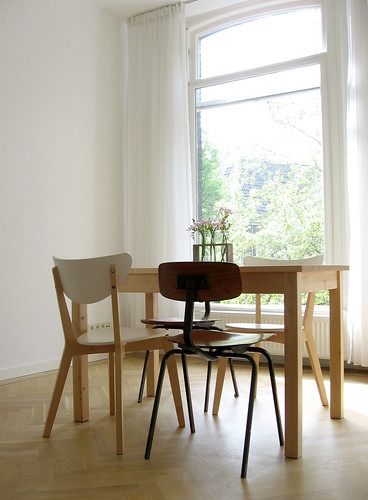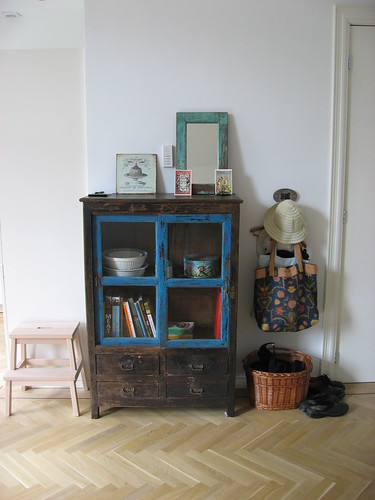
glowy dining room lighting
In the spirit of our pre-move decluttering, I've been trying to be good about tossing things out and thinking carefully about what new things to add. One thing I'm doing is not buying things in anticipation of needing them. For example, I haven't bought a toaster yet because we don't usually eat much toast in the summer. When winter rolls around, we'll probably buy one, but for now we just use the broiler in the oven. I do have to fight against my it-might-be-useful-someday tendency in terms of hanging on to things. But it always helps to remember the amount of such stuff that wasn't ever useful that I had to get rid of before we moved. Stuff does have a tendency to multiply in the back of dark cupboards. I want to write down what was actually involved in our pre-move purge before I forget and hopefully it will be helpful to others.

cabinet of curiosities
De-cluttering is not a quick job. It takes a lot of mental energy and many iterations. If you try to do it in one pass, you're more likely to make bad choices. If you're rushing it, you'll cling to things you don't need just because you're sick of getting rid of stuff and you'll toss stuff you'll miss just because you're tired of making decisions. Motivation is a huge part of the job. Moving overseas was an excellent inspiration to be more thorough than we had ever been before. If you don't have to minimize your stuff, it will be a lot harder to let go of things. So state your goal clearly to yourself and keep it in mind when evaluating each thing.
My steps for decluttering:
- Quickly ditch all the things from the house that you already meant to get rid of (for us this was an old stereo and a box of clothes set aside for the Salvation Army). This should be fast because you've already made the decision, and getting it out of sight will feel like good progress.
- Go through the sets of things that you know you can trim down (clothes/shoes, books/movies/music, kitchen housewares, etc) and get rid of anything you don't like or don't use enough to make it worth keeping. The more honest you are about what you don't like or use, the better the results.
- Repeat step 2 several times, over the space of several weeks. You need the time so that each time you look at your stuff, you come back to it with fresh eyes. You'll be surprised at the end by things that you kept on the first pass. There are obviously some things that are not frequently used, but are still worth keeping, but it's important to remember that you can borrow things, rent things, and even buy things again if necessary.
- Now that you've got the obvious excess trimmed down, go through absolutely everything, starting with one cupboard or drawer at a time. Look at EVERYTHING (including the things you've already gone through several times). If you don't look at it, there's no chance you'll get rid of it. This step is really tedious, but it's also the most likely to turn up things you didn't even realise you HAD! You should have reduced a lot by this point and you might be pretty mentally exhausted. To de-clutter to the fullest extent, there's one more thing to keep in mind: Can I live without it? The key is to acknowledge that you can like and use something and still decide that you'd rather have more space and less stuff than owning that thing.
- The last step is maintenance. To make all that hard work worth it, you need to keep returning to your evaluating mindset. Think carefully when acquiring new things, and review the stuff you've kept as your life and activities change.
Throughout the process, be truly honest with yourself about why you're keeping things. I, for example, had a number of pairs of shoes that I liked the look of, but hardly wore because they hurt my feet. I was resistant to getting rid of them, though, because of what they cost. I thought that if I kept them, I might eventually wear them, thus getting some value. In reality all I was getting was hits of guilt for not wearing them every time I saw them. It took me quite a number of decluttering passes to realise this. I was eventually able to "throw them on the fire" as we took to calling the act of tossing things in the box to be donated. It turned out to feel amazing to throw away the guilt that was associated with those shoes.

lisianthus in the living room
Photographs by Allison Gryski. © All rights reserved.

0 comments:
Post a Comment